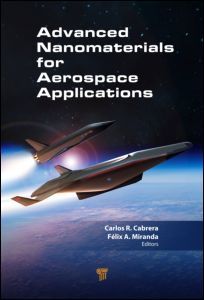Advanced Nanomaterials for Aerospace Applications
Coordonnateurs : Cabrera Carlos R., Miranda Félix

Advanced Nanomaterials for Aerospace Applications has been developed for a community interested in space science and nanotechnology. Scientists and engineers from several NASA field centers and the Jet Propulsion Laboratory, University of Puerto Rico, The Pennsylvania State University, and INFN-Laboratori Nazionali di Frascati, Italy, have joined efforts to discuss the applications of nanomaterials in sensors, atmosphere revitalization in habitable space platforms, life support systems, regenerative fuel cells, lithium-ion batteries, robust lightweight materials, nanoelectronics, and electromagnetic shielding. The book concludes with chapters that discuss bringing NASA-relevant nanotechnology into the classroom and the future directions in nanotechnology research and development at NASA.
Advanced Sensor Nanomaterials for Aerospace Applications, Gary W. Hunter, Jennifer C. Xu, and Laura J. Evans
Challenges and Possibilities in Nanosensor Technology, Gary W. Hunter, Laura Evans, Jennifer Xu, and Azlin Biaggi-Labiosa Nanoporous Materials in Atmosphere Revitalization, Arturo J. Hernández-Maldonado, Yasuyuki Ishikawa, Raphael G. Raptis, Bernadette Luna, Lila Mulloth, Christian Junaedi, and Subir Roychoudhury
Nanomaterials for Advanced Lithium-ion Battery Anodes, Richard S. Baldwin, James J. Wu, and William R. Bennett
Advances in Designing High Energy Cathode Materials for Li ion Rechargeable Batteries, Ram S. Katiyar, and Gurpreet SinghNanomaterials in Regenerative Fuel Cells, Thomas Valdes, Ileana González-González, and Carlos R. Cabrera
Nano-Technology in Advanced Life Support: Water Recycling, Michael Flynn, Eduardo Nicolau, and Carlos R. Cabrera
Nanotechnology for Nanoelectronic Devices, Félix A. Miranda and Harish M. Manohara
Brief Introduction to Nanocomposites for Electromagnetic Shielding, S. Bellucci and F. Micciulla
Epoxy Nanocomposite based on Carbon Nanotubes for Electromagnetic Interface (EMI) Shielding, S. Bellucci and F. MicciullaBringing NASA-relevant Nanotechnology Research into the Classroom, Ana-Rita Mayol, Christian Menéndez, Melissa Dávila, and Liz DíazFuture Directions in Nanotechnology R&D at NASA, Michael A. Meador
Dr. Carlos Cabrera is professor at the Department of Chemistry of the University of Puerto Rico, Río Piedras Campus. Cabrera’s main research area is on the development of nanocatalysts for clean energy technology such as fuel cell systems. This energy system is of importance for the development of environmentally friendly energy conversion and storage based on alcohols. Fuel cells are becoming a promising clean energy system for vehicles, portable devices, and power generators. This area of research is part of the research conducted at the Institute for Functional Nanomaterials (IFN). Through the institute, Cabrera will develop catalytic nanomaterials for fuel cell testbeds and prototypes that will be evaluated at the NASA Glenn Research Center in Cleveland, Ohio. This creation of the IFN is creating a unique opportunity for the further development of Cabrera’s nanotechnology research since new state-of-the-art instrumentations and unique partnerships will be established with nanotechnology centers located at Purdue University, University of Massachusetts, Northwestern University, Cornell University, and the Argonne National Laboratory.
Dr. Félix A. Miranda received his B.S. degree in physics from the University of Puerto Rico in 1983, an M.S. degree in physics from Rensselaer Polytechnic Institute, USA, in 1986, and a Ph.D. degree in physics from Case Western Reserve University, USA, in 1991. He is currently chief of the Antenna and Optical Systems Branch in the Communications, Instrumentation, and Controls Division. His areas of expertise are antenna technology, ferroelectric tunable microwave components, and microwave integrated circuits and devices for space and ground-based communications.
Date de parution : 07-2014
15.2x22.9 cm
Thèmes d’Advanced Nanomaterials for Aerospace Applications :
Mots-clés :
NASA GRC; CNTs; Challenges and Possibilities in Nanosensor Technology; Smart Sensor Systems; Nanomaterials for Advanced Lithium-ion Battery Anodes; Lithium Ion Batteries; Nanotechnology for Nanoelectronic Devices; Fuel Cells; NASA Jet Propulsion Laboratory; Energy Density; Future Directions in Nanotechnology R&D at NASA; Bet Surface Area; PEM; Case Western Reserve University; High Specific Capacity; CNT FETs; Regenerative Fuel Cell; Mixed Matrix Membranes; NASA Mission; AC Conductivity; Oxygen Evolution Catalyst; FO Membrane; Electrochemical Performance; Fuel Cell System; TEM Holder; Carbon Nanotube Fibers; Co-doped Films; FO; Cathode Material; Block Copolymer Membranes



